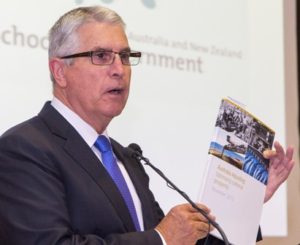Migration boost would be fuel for Australia’s economy – report
Doubling Australia’s migrant intake could dramatically boost economic growth into the future, according to a new economic report.
The report from the Committee for Economic Development of Australia (CEDA) says skilled migration in particular has always been a significant driver of Australia’s economy.
But it says the current flow of new arrivals into Sydney and Melbourne will not be sustainable unless policies change.

Stephen Martin
The CEDA report proposes doubling Australia’s migration intake to 400,000 by the 2050s.
But it says should only occur if gaps in infrastructure, urban congestion and environmental impacts are adequately addressed to cope with new arrivals.
CEDA chief executive Stephen Martin says higher migration would deliver a 5.9 per cent increase in gross domestic product per capita.
“The question about the benefits that would come clearly have to be offset by considering things like ‘where are those people going to settle’,” Professor Martin said.
“If they are continuing to go into the capital cities of Australia, particularly Sydney and Melbourne, that potentially can play into congestion problems and so on.
“So as a consequence our report has also recommended that government policy should be tweaked to provide some encouragement for migrants coming to Australia to go to regional areas and we believe that by changing the point system this would be one way of encouraging that sort of population distribution,” he said.
The report said Australia’s migration program could also be altered to shift the settlement patterns of migrants. It recommends the introduction of a points system that allocates extra points to migrants prepared to settle in regional areas, especially northern Australia.
“Australia could absorb a greater migration intake, but this could only be done in conjunction with complementary policy that addresses adverse consequences of population growth such as infrastructure provision, urban congestion and environmental degradation,” Prof Martin said.
“There needs to be better long-term planning around population growth, taking into account potential migration patterns.”
Australia takes a disproportionately large component of the world’s migration flows. Despite having just 0.3 per cent of the world’s population about 2.8 per cent of the world’s immigrants live in Australia, the report said.
It said there are now more people living in Australia who were born overseas, as a portion of the population, than at any other time in the last 130 years. This is the highest portion in the world, after Israel.
“The simple fact is migration has contributed substantially to the growth of Australia and will continue to do into the future,” Prof Martin said.
Modelling that compares zero net migration with a continuation of current trends shows that, by 2050, the higher immigration scenario delivers a 5.9 per cent increase in GDP per capita. By 2050, births in Australia will no longer outnumber deaths leaving immigration as the only source of population growth.
But the report calls for more robust tests for permanent skilled migration and 457 visas including “tightening entry requirements relating to age, skills and English-language proficiency”.
It also recommends a cap on the working holiday visa program and a new “purpose-built” guest worker program to meet the needs of specific industries struggling to attract low-skilled workers.
The report said that a trend which sees rising fears about migration could threaten to undermine Australia’s longstanding and successful migration program.
“Key aspects of the current migration program have the potential to undermine its community acceptance and fuel these fears,” the report said.
“An over-reliance on poorly regulated market-driven components of the program and the very substantial pools of relatively unregulated temporary migrants create opportunities for exploitation…while also having economic consequences for some incumbent Australians,” it said.
Laurie Nowell
AMES Australia Senior Journalist













